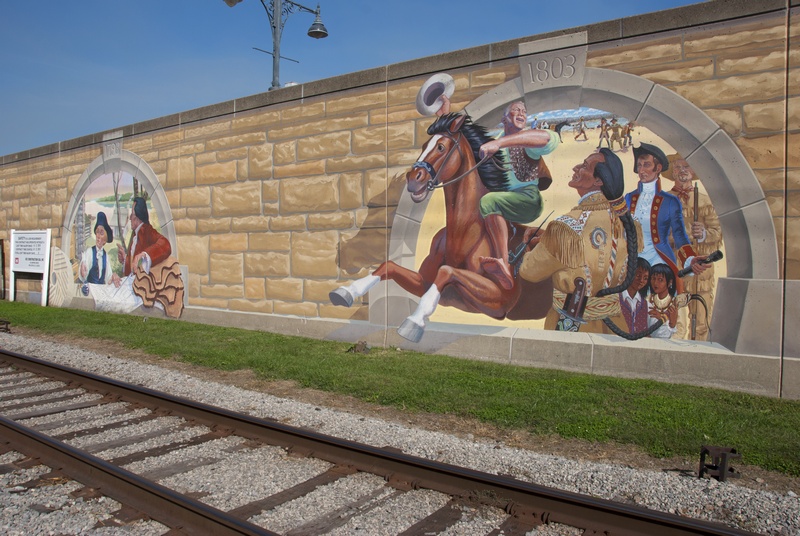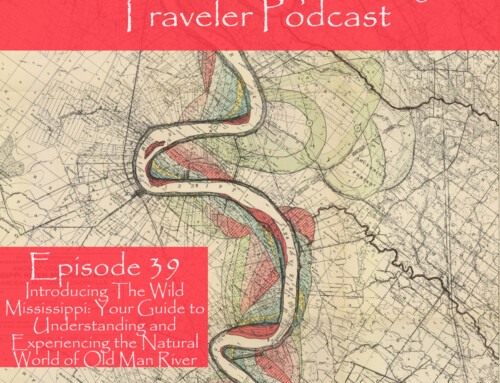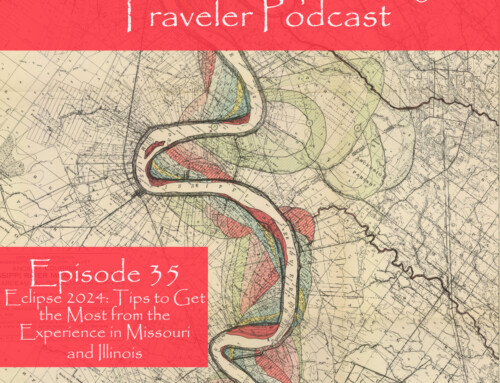Spring is in the air, at least for the lower two-thirds of the Mississippi Valley. Birds are on the move already, and early spring flowers are popping up in my part of the river. With migration season just getting going, it’s a good time to talk about a few places where it’s relatively easy to appreciate all those birds on the move.
In this episode, I describe five day trips that’ll get you outside and close to the birds. Each day trip includes two or three places to hike and ends with a recommendation about where you can rest and refuel with beer (or another beverage of your choice) and food. The day trips in this episode are based around New Orleans, Memphis, St. Louis, the Quad Cities of Iowa and Illinois, and Galena, Illinois. In the Mississippi Minute, the spring rises along the river remind me of flood walls and the creative ways some river cities have tried to decorate them with art.
Show Notes
Day Hike 1: Around New Orleans
Barataria Preserve at Jean Lafitte National Historic Park and Preserve
Day Hike 2: Memphis Area
Meeman-Shelby Forest State Park
Old Forest State Natural Area at Overton Park
Day Hike 3: St. Louis Region/Illinois Great River Road
Riverlands Migratory Bird Sanctuary
John Olin Nature Preserve (trails reopen for the season on April 1)
Pere Marquette State Park Lodge
Day Hike 4: Quad Cities Region (Iowa and Illinois)
Day Hike 5: Around Galena, Illinois
O’Leary’s Lake Recreation Area
Bonus Tip
Support the Show
If you are enjoying the podcast, please consider showing your support by making a one-time contribution or by supporting as a regular contributor through Patreon. Every dollar you contribute makes it possible for me to continue sharing stories about America’s Greatest River.
Don’t want to deal with Patreon? No worries. You can show some love by buying me a coffee (which I drink a lot of!). Just click on the link below.
Transcript
SUMMARY KEYWORDS
trail, forest, river, park, birds, hike, wetlands, miles, area, riverlands, galena, mississippi, check, road, upland, find, place, beer, marsh, mississippi valley
SPEAKERS
Dean Klinkenberg
Dean Klinkenberg 00:00
It’s time to get back outside the hike and enjoy the return of those birds and flowers, leaves, warmer air, and spring allergies.
Dean Klinkenberg 00:13
with band aids
Dean Klinkenberg 00:29
Welcome to the Mississippi Valley Traveler Podcast. I’m Dean Klinkenberg, and I’ve been exploring the deep history and rich culture of the people in places along America’s greatest river, the Mississippi, since 2007. Join me as I go deep into the characters and places along the river and occasionally wander into other stories from the Midwest and other rivers. Read the episode show notes and get more information on the Mississippi at Mississippi Valley traveler.com. Let’s get going.
Dean Klinkenberg 00:59
Welcome to Episode 15 of the Mississippi Valley Traveler podcast. Last week, a million snow geese made a rest stop in northwest Missouri which got me thinking a lot about birds and spring, nothing better than thinking about spring. There are a lot of birds on the move already, not just those snow geese. Sandhill cranes are gathering in Nebraska right now. Bald eagles are slowly moving back north as the ice retreats from lakes and rivers. Other waterfowl are on the move, too, and pretty soon songbirds will be joining them all. It’s time to get back outside to hike and enjoy the return of those birds and flowers, leaves, warmer air, and spring allergies. In this episode, I’m going to suggest a few hikes that offer a mix of wetlands where you can observe waterfowl, plus some forested areas where you may spot or hear songbirds. You may also catch some early spring flowers on these hikes. And since these hikes could take the better part of a day, I’m also going to recommend a place where you can stop for a beer and a bite to eat. If you’re not a beer person, no worries. These places have more to offer than just beer.
Dean Klinkenberg 02:05
I’ve put together five day trips around areas from New Orleans to Galena, Illinois. The snowpack is still pretty thick up in Minnesota and Wisconsin, so we’ll do another episode later to talk about spring travel in the upper reaches of the Mississippi Valley. And if you get tired of taking notes during this episode, if you’d rather just listen, don’t worry. I’ll put in the shownotes a list of all the places that I mentioned in this episode, just head to MississippiValleyTraveler.com/podcast and look for the episode on spring birding and beer. As usual, my thanks go out to all those Patreon supporters who make this podcast possible. If you’d like to show some love, too, you can join the Patreon community or just buy me a coffee. I drink a lot of coffee after all, so buying me a coffee is a pretty big deal. Just go to MississippiValleyTraveler.com/podcast where you can find out about all about how to do either one of those things. So let’s get going.
Dean Klinkenberg 03:14
Well, let’s kick this off with three places to visit in and around New Orleans, where the weather is already heating up. As I mentioned at the top of this episode, I’m going to be talking about a few different places where you can take a hike and then some place you can stop afterwards, or I suppose in between, for a bite to eat and maybe something to drink. So down in the New Orleans area, we’re going to start at the Barataria Preserve at John Lafitte National Historic Park and Preserve, which is a really easy drive from New Orleans. The Barataria Preserve is charming and seductive, lush with greenery, birds, snakes, and alligators. Cypress-tupelo swamps are a common sight, as are some marshes and bayous, and a little bit of bottomland hardwood forest. The plants that grow in the preserve vary with subtle changes in elevation, so just a foot difference might turn a cypress swamp into a marsh, for example. I’d suggest you start with a tour of the visitor center where you can kind of get oriented to the different options for hiking, and then take a walk around the boardwalk trail that winds through the swamp and marsh behind the visitor center itself. Just a short distance away Bayou Coquille offers a peaceful walk on a well maintained trail that passes through some cypress swamp and bottomland forest, and a little bit of brackish marsh, as well, in a pretty short, less than a mile one-way hike. The Palmette Trail runs about a mile through what you would expect–a palmetto-model rich forest–and connects the visitor center with the bayou Coquille parking lot. There are a few companies that also offer leisurely tours of the Barataria swamp in slow boats or fast air boats. Most emphasize alligator spotting over everything else, but you’d probably see some birds on those, as well. The Barataria Preserve is roughly a 25 minute drive from the French Quarter.
Dean Klinkenberg 05:05
Also on the west bank of the river, the Woodlands Conservancy occupies land in a big band in the Mississippi known as English Turn. You can wander through almost 650 acres of bottomland hardwood forest in an area that’s called the Woodlands Preserve. There about 13 miles of hiking trails that wander through the woods, some of which are reserved for horseback riding only. Besides birds, you may spot some swamp rabbits and maybe even an alligator in the canal. The upland trail is an easy mile-long walk along a ridge and next to the canal passes through forest and a meadow before returning to the parking lot. Native trees along the trail include live oak, water tupelo, some swamp red maple, hackberry, and elderberry. The Bottomland Trail runs a couple miles through the forest. There are separate but parallel trails for hikers and for horseback riders. If you follow the trail to the end, you’ll get a bit of a surprise. You’ll find several concrete shelters that were built by the US government during World War Two to store ammunition. You can take a longer hike from there another couple of miles by following the North Trail near those ammo depots. If you hiked the entire Bottomland Trail, Depot Loop and North Loop the total distance is about five and a half miles. That’s a pretty good hike. The trails are open to the public daily from dawn to dusk.
Dean Klinkenberg 06:30
As it turns out, though, you don’t have to leave the city to find a good place to enjoy spotting or listening to birds. Couturie Forest in city park offers dense, lush woods and is smack dab in the middle of the city. Couturie Forest features 60 acres of bottomland hardwood forest and wetlands, which are a magnet for birds and bird lovers. A bunch of trails criss cross the forest, including a few that go around the city’s highest point, a place known as Laborde Mountain that rises all of 43 feet above sea level. The parking lot and entrance to Couturie Forest are along Harrison Street, just west of the middle of city park. It’s about a 15-minute drive from the French Quarter or a slightly longer bike ride along the Lafitte Greenway. You could also get there on the Canal Street streetcar, the City Park/Museum route.
Dean Klinkenberg 07:22
After all that work, you might be a little hungry or thirsty. I think you should give a shot to the Faubourg Brewing Company, which is more than just a place to sip. It’s a also leisure destination. You can relax there with your beverage of choice and a meal in the sprawling outdoor beer garden. Or if you’d like you can do something a little more active. Check out the bocce ball courts, maybe play a little disc golf or yard dominoes, or any of the other outdoor games.
Dean Klinkenberg 07:51
Well, let’s continue on. Let’s head a little bit up river. Our next stop is going to be the Memphis region and just like New Orleans, the Memphis area has a nice mix of hiking options, even within the city limits. Let’s start with Meeman-Shelby Forest State Park, which is a short drive north of the city. It’s a beautiful place and conserves large tracts of forest from upland forests on the ridges of the loess hills known as the Chickasaw Bluffs to thick bottomland hardwood forest. The park’s 13,000 acres also includes a couple of lakes and access to the main channel of the Mississippi. And given this variety of habitat habitats, it’s really no surprise that the park supports a diverse group of plant and animal life, especially birds. The park’s 20 miles of trails offer some good choices for getting into those forests and around the wetlands. The Chickasaw Bluff and Woodland Trails, for example, wander through the upland forests, eight miles long for the Chickasaw Bluff trail if you do the whole thing from end to end, and about three and a half miles for the Woodland Trail. This time of year, the blooms are just beginning to pop and if you wait a couple more weeks, they should be pretty abundant along some of these trails. If you’d rather bike through the forest, the park also maintains a five mile paved bike path just for bicycles. Now another option in the park–it’s not a hike, you’ll have to get in your car to do this or you could bike it–there’s a seven mile drive, a seven mile road from the visitor center to the boat ramp on the Mississippi. I think you’ll find that you will enjoy taking this as a slow pace as you wind your way under the thick canopy of the floodplain forest. You’ll probably see a lot of birds along the edges of the road and when you get to the boat ramp at the end, you’ll find it’s a popular spot to enjoy watching the river but especially watching the sunset over the river in the evening.
Dean Klinkenberg 09:46
Back in the city limits the Old Forest State Natural Area in Overton Park is a wonderful bit of old growth deciduous forest in the middle of Memphis. Hard to believe there’s a place like this in the middle of a big city. There are slight elevation differences throughout the forest that change the makeup of the plants. On the ridges, southern red oak and tulip popular are common. But you’ll see pockets of cherrybark oak and sweet gum where the ground is just a little bit lower. And in the understory, if you look down, you’ll see some dogwood, redbud, hop hornbeam, red maple, and paw paw, which will produce those delicious fruit. You can’t help but notice that the forest has a lot of big old oaks. But trees only account for 20% of the plant life in this old growth forest. If you walk around the network of trails, and there are a whole bunch of them, the park feels bigger than the 126 acres that it actually occupies. That dense canopy and vegetation really knock down the heat of the day, and the forest buffers a lot of the city’s noise. It’s a, it’s a really rewarding place to wander around in search of birds, flowers, or just peace and quiet.
Dean Klinkenberg 10:57
Now if you go a little south of downtown Memphis, I really enjoyed visiting TO Fuller State Park, another impressive refuge not far from the city’s bustle. TO Fuller opened in 1933 as Shelby City Negroes State Park. It was one of only two state parks in Tennessee that welcomed African Americans at that time. In the 1930s, workers from the Civilian Conservation Corps remade the park, complete with new buildings and trails and roads and a lot of new plantings. When the CCC was in the process of doing all that work, a few workers uncovered evidence of an old village while excavating for a swimming pool. Archaeologists subsequently determined that indigenous North Americans began living at that site about 1100 years ago, and it was probably one of the communities that was ransacked by Hernando de Soto’s army. The site, which today we call Chucalissa Village is part of the CH Nash Museum, which is managed by the University of Memphis. In 1942, the county renamed the park for Dr. Thomas Oscar Fuller, a successful educator and entrepreneur, who nurtured black owned businesses, wrote books about African American history, and served as editor for a literary publication called The Signal. The county sold the park to the state of Tennessee in 1949. And the state park today covers almost 1200 acres. The interpretive center, a good place to start for any visit, includes exhibits on the native plants and animals in the park, as well as displays on the park’s history. Several miles of trails pass through the beautiful upland deciduous forests of the fourth Chickasaw Bluff. The Discovery Loop Trail winds four miles through upland forests with some some minor elevation changes. It also passes by the Chucalissa site and some wetlands. If you just want to walk around the Chucalissa site, you can follow the three-quarter mile loop trail. The Initiation Loop covers two and a half miles through upland forest and it’s a bit more work than the other trails. It goes from the top of the bluff to the floodplain so the elevation changes about 400 feet along the route. Might be good to have a couple of walking poles or sticks with you on that one. The park is in the process of restoring the former golf course that closed in 2011 to native grassland, as well as restoring some wetlands around there as well, both of which are still good spots for birdwatching. The park resurfaced the former golf cart paths with a material made from recycled tires, so it’s easy on the feet and legs. And that trail runs almost three miles. Weekends the park can get a little busy, but it is still a peaceful place in spite of its proximity to the big city and there’s almost always a corner, a quiet corner somewhere that you can find even on a busy weekend.
Dean Klinkenberg 13:49
Now, after all that work hiking, you gotta have to quench your thirst and get a bite to eat. I would suggest going to the Crosstown Brewing Company. It’s a really festive place just east of downtown, where you can relax and enjoy a locally crafted beer, maybe take in some music if you hit the time just right. And you can enjoy food from one of the food trucks that stop by. If you really have your heart set on eating while you’re there, I suggest you check their website in advance and look at the schedule when food trucks are there, just to make sure you’ll be able to eat something during your visit.
Dean Klinkenberg 14:25
As we continue up river, our next stop is the St. Louis region, my hometown. But this daytrip actually features places that are north of the city and above the confluence of the Mississippi and Missouri Rivers. There are a lot of lands up there to explore, and I’m going to highlight a couple of them that should be teeming with birds in the spring. So first up, we’re going to take you to Riverlands Migratory Bird Sanctuary. When the US Army Corps of Engineers built the billion dollar Mel Price Lock and Dam, they rebuilt woods and wetlands as mitigation for the environmental impact for the massive project. The sanctuary today covers about 3700 acres, about a third of which is wetlands. When you visit, you can hike a short trail through a patch of native prairie that’s being restored along the shores of Ellis Bay. Or you can take a hike on Ellis Island. You’ll find plenty of places to pull over along the road to observe birds which are present in big numbers in spring.
Dean Klinkenberg 15:25
Given the abundance of birds at the sanctuary, it’s no surprise that the Audubon Society operates an Education Center at Riverlands, so you can also visit the Audubon Center at Riverlands and check out the exhibits on native wildlife and spend some time looking through the strategically positioned viewing scopes. Riverlands and the Audubon Center are just across from the Clark bridge from Alton, Illinois, about 30 minutes from downtown St. Louis.
Dean Klinkenberg 15:53
If you’ve got an extra hour or so, while you’re there at Riverlands you may as well continue on down the road a little bit to Edward “Ted” and Pat Jones Confluence State Park, where you can have a close encounter with the confluence of the Mississippi and Missouri Rivers. If the water is not too high, you can walk onto the narrow slice of land between the rivers, where you’ll have the Mississippi on one side of you and the Missouri on the other. The road to the parking lot passes through wetlands in various stages of being restored, and they also attract a lot of birds. From Riverlands Way it’s about a four and a half mile drive down a gravel road to reach the parking lot at the confluence and the park will close if the rivers are too high. You’ll find that out soon enough when you head to the to the gate.
Dean Klinkenberg 16:40
Now once you’re done there at Riverlands, you can cross the Clark Bridge into Illinois and head on up to John Olin Nature Preserve at Godfrey. It’s owned and managed by The Nature Institute. The Preserve is 150 feet above river level and along and behind bluffs that line the Mississippi, and you’ll find a bunch of scenic hikes through upland forests and along rocky streams and dense woods. As you might expect, the woods and streams attract a lot of birds and other animals. There are several trails that loop through the area which roam down to the stream and back up. The stream cuts through a very narrow valley and runs across a limestone bed and has a small little waterfall at the far end of the trail. You can also walk around an area where native prairie is being restored. It’s just kind of fun to check out at different times of year. There should be some flowers popping there pretty soon. The Preserve, as I record today on March 7, the Preserve is currently closed but the trails will be open to the public again on April 1.
Dean Klinkenberg 17:42
The third option on this itinerary is not on the Mississippi River directly but it’s awfully close. Pere Marquette State Park is just a few miles up river of where the Illinois River merges with the Mississippi and it is a beauty. The park has 8000 acres along the rolling hills next to the Illinois River, and so you’ll find upland deciduous forests, some bottomland hardwood forests, and wetlands, all of which attract a nice variety of birds. You’ll find 12 miles of trails that work their way up and down through the woods and some of the ascents are fairly steep. This is not as casual a hike as some of the others. You’re gonna get a bit of a workout. The Twin Mounds Trail, for example, climbs from the floodplain to the top of the bluff, so when you reach the top, your reward is splendid views of the Illinois River Valley.
Dean Klinkenberg 18:33
Well after you’re done with that hiking and exploring, you know you’ve got a couple of options. You can stay in Pere Marquette and you could enjoy a nice meal at the restaurant, in the 1930s-era lodge at Pere Marquette State Park. If you’re not starving, I’d suggest though you drive back to Alton–it’s about a half hour to get back down there–and enjoy a beer and a meal at the Old Bakery Beer Company.
Dean Klinkenberg 18:58
And we continue our journey up the Mississippi. As we continue north from St. Louis, I’ve got some ideas for bird spotting around the Quad Cities of Iowa and Illinois. Once a toxic mess of a marsh, Nahant Marsh today is an oasis in an industrial zone. It’s been cleaned up and restored, so the marsh today offers over 300 thriving acres of wetlands that attract a variety of birds throughout the year, but it’s especially teaming in spring. If you’ve got some time, visit the Education Center where you can check out the exhibits on wildlife, and on some weekends or evenings you’ll also, you may also come across some public programs or speakers. There are three flat trails that wind around the marsh. If you walk their entirety, you’ll cover about two miles, very leisurely walks. The trails pass through little bits of bottomland forest and next to wet meadows and prairie. In the bottomland forest, there’s a blind just off the trail which is a handy place to watch the birds that are hanging hang out in the marsh. The grounds are open daily so if the gate is locked you can enter the trails from the parking lot.
Dean Klinkenberg 20:06
While Nahant Marsh is an easy place to explore because it’s an it’s such a compact site, Loud Thunder Forest Preserve sprawls over 1400 acres of rolling hills along the Mississippi River. You can easily get lost at Loud Thunder. You’ll find mostly dense upland forests at Loud Thunder that cover the hillsides, but there are some narrow strips of bottomland forest and access to the main channel of the river. 12 miles of trails criss cross the park, the longest of which cuts through the upland forests and are managed for both hiking and horseback riding. So you know this time of year, if there’s a lot of folks riding horses, the trails can get a little rutted from the steps of the horses, if it’s been raining especially. So you might look for another part of the park to hike in. But this time of year there should also be a lot of birds that are starting to show up in those woods. The eastern portion of the Hauberg Trail follows the river pretty closely and it passes through bottomland forests with a thick understory, or at least it’s thick by summer, and there are a few hills and a few ups and downs along that way. Most of the hiking at Loud Thunder is going to involve climbing some hills, so be prepared for that. If you’re going to hike the Hauberg trail, you can park at the boat ramp and walk to the trailhead, which is on the far side of the campground from where the boat ramp is from the trailhead. When I hiked there, I hiked about a mile to where the trail dipped right down next to the river. It looked to me like that was about where the trail ended. And then I turned around and went back so it was about a two mile hike round trip from that spot. But there are other places the Hauberg trail continues, in the other direction from the boat ramp, as well, and that would also be a good place to explore.
Dean Klinkenberg 22:01
So when you’re ready to chill with a beer and some food, I’d suggest heading back to Davenport’s Front Street Brewery which is right on the river and serves very tasty food and beer. It’ll take you about a half hour to get to Davenport from the Loud Thunder Preserve.
Dean Klinkenberg 22:17
Alternatively, you could just continue on west to Muscatine. It’s only about 20 minutes from Loud Thunder. And at Muscatine, you could check out Contrary Brewing, which is also right on the river and serves up tasty, locally brewed beer that you can enjoy with a pizza or a snack.
Dean Klinkenberg 22:34
So I’m going to wrap up this set of recommendations by going a little further north again, this time up around Galena, Illinois. I’ve got places I really like for this area, but they’re a little further apart than some of the others. So if you hit them all it’s about a 50 minute drive from the furthest apart at the west end. So we’re kind of, we’re gonna start northwest of Galena and head up toward Potosi, Wisconsin, and just at the west end of Potosi, just where the highway takes a sharp turn to the north, a little road continues under a railroad bridge and along a narrow spit of land that juts out into the river’s backwaters. This little area is known as Potosi Point and it’s almost always a terrific place to watch birds and other wildlife. It’s absolutely one of my favorite spots to go when I’m up in that part of the river. You can pull over along the road if there’s space to do so or just continue until the road ends. It ends at a small little parking lot. Bring a couple of chairs, some binoculars and settle in to watch the goings on around you. You might share some of the space with people who are fishing, especially on weekends. But the views, like I said are absolutely terrific, as you’re almost entirely surrounded by the river at the end of that point.
Dean Klinkenberg 23:49
If you don’t want to drive up to Potosi, and I don’t know why you wouldn’t, you can head over to O’Leary’s Lake Recreation Area instead, which is only about 20 minutes from Galena. It’s a shallow bay located just above the Dubuque Lock and Dam, number 11, and attracts a lot of waterfowl. If you’re gonna get there from Dubuque, you just take Highway 61 north into Wisconsin, take the exit for Badger Road, go left on Sandy Hook Road, then left again on Eagle Point Lane. And you’ll know when you’re there–there’ll be a lot of water.
Dean Klinkenberg 24:19
Now on the other side of Galena, there’s another sprawling wildlife area I really enjoy: Witkowsky State Wildlife Area. It offers a chance to hike through 1000 acres of varied Driftless Area ecosystems. You’ll find upland forest, red and white oak and hickory, growing along the ridges along, alongside some prairies. As you descend from the hills down into the creek valleys and bottomland forests, you’ll find some wetlands and prairies intermingling with all of those. They’re about six parking areas next to the trailheads that offer access to the interior of the property and its 10 miles of wide, well maintained trails that crisscross expect gentle rolling hills, thick stands of trees, scenic limestone outcroppings and patches of prairie grasses and flowers, all terrific places for birds. If you’ve got time the Walnut Trail Loop, which runs about six miles, passes through many of these areas, but you’ll you’ll be able to find some options for shorter hikes too. But again, the terrain tends to be pretty hilly, so be prepared for that. Blackjack Road gets a little busy at certain times of the day, especially for a country road. It’s the road that runs along Witkowsky Wildlife Area, but you really won’t hear any car noise once you’re on the trails in the woods.
Dean Klinkenberg 25:40
Now, when you’re ready to relax and drink and eat a little bit, I’ve got a couple of options again for you. So many options! If you’re up in the Potosi area, you really should try to make time to stop at the Potosi Brewery for food and some really good beer. The brewery has a long history in the area that ended in 1972, then it was resurrected by a local group that renovated the building and reopened the brewery in 2008. I am a big fan of their beer and they offer a full menu for lunch and dinner.
Dean Klinkenberg 26:14
If you want to wait until you get back to Galena, that’s fine, you can do that. Then I’d say head to the Galena Brewing Company. The spacious brew pub occupies one of the historic storefronts along Main Street. The beer is good and the pub grub menu is satisfying as well.
Dean Klinkenberg 26:29
Before I wrap up this segment, I’ve got a bonus tip for y’all. The River to River Trail Society offers guided hikes throughout the spring and fall in Shawnee National Forest in Southern Illinois. I’d suggest you go to their website, which is rivertorivertrail.net where you can check out the calendar and subscribe to their blog. So you get email alerts to find out what’s coming up but their calendar is already filling up with guided hikes this spring. So if you’re anywhere near Southern Illinois or think you’re going to be there, you might be able to go along with one of those hikes. They’re typically on weekends, often on a Saturday morning. So so check that out and let me know what you think.
Dean Klinkenberg 27:10
If you want to know more about the Mississippi River, check out my books. I write the Mississippi Valley Traveler guide books for people who want to get to know the Mississippi better. I also write the Frank Dodge mystery series that is set in places along the Mississippi. My newest book, Mississippi River Mayhem, details some of the disasters and tragedies that have happened along Old Man River. Find any of them wherever books are sold.
Dean Klinkenberg 27:42
And now it’s time for the Mississippi Minute. It’s spring, which means the rivers start to rise and people begin to worry about flooding and just how high the river is going to get this year. So I was thinking, if you’re out and about as the river is coming up, and you’re looking at how high the river is getting at some of the cities along the river, you’ll notice there are flood walls, and some of those flood walls have been decorated with murals. Now, I want to highlight a few of these and suggest that you take some time to walk along and check out the art on some of the flood walls that exist in our river towns. Down in Cape Girardeau, there’s a series of 24 murals along the city’s flood wall that show different scenes from the city’s history. They were designed by Chicago artist Tom, Thomas Melvin, and painted in 2005 with the help of a bunch of local artists. At St. Louis, the flood wall south of The Arch also has a bunch of paintings on it. In fact, the paintings tend to change pretty regularly because they’re all regularly repainted over Labor Day weekend as part of the festival called Paint Louis, when graffiti artists come here to decorate the wall and show off their skills. Some of the designs are absolutely gorgeous and it’s hard to believe the skill of the folks who are involved who can create beautiful art with spray paint, but it’s fantastic. I really suggest just taking some time to go through there and check out the the beautiful graffiti art. Those aren’t the only cities that have paintings along the front on the flood walls though so if you’re on the road, I’d also say check out the art on the flood walls at Cairo, Illinois, Hickman, Kentucky and Vicksburg Mississippi. Visit those places and let me know what you think.
Dean Klinkenberg 29:36
Thanks for listening. I offer the podcast for free but when you support the show with a few bucks through Patreon, you help keep the program going. Just go to Patreon.com/DeanKlinkenberg. I’d be grateful if you’d leave a review on iTunes or your preferred podcast app. Each review makes a difference and helps other fans of the Mississippi River and the Midwest find this show. The Mississippi Valley Traveler podcast is written and produced by me, Dean Klinkenberg. Original Music by Noah Fence. See you next time






